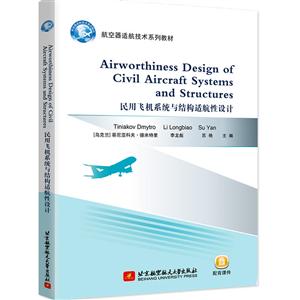-
>
中医基础理论
-
>
高校军事课教程
-
>
思想道德与法治(2021年版)
-
>
毛泽东思想和中国特色社会主义理论体系概论(2021年版)
-
>
中医内科学·全国中医药行业高等教育“十四五”规划教材
-
>
中医诊断学--新世纪第五版
-
>
中药学·全国中医药行业高等教育“十四五”规划教材
民用飞机系统与结构适航性设计 AIRWORTHINESS DESIGN OF CIVIL AIRCRAFT SYSTEM 版权信息
- ISBN:9787512427624
- 条形码:9787512427624 ; 978-7-5124-2762-4
- 装帧:一般胶版纸
- 册数:暂无
- 重量:暂无
- 所属分类:>>
民用飞机系统与结构适航性设计 AIRWORTHINESS DESIGN OF CIVIL AIRCRAFT SYSTEM 本书特色
Abstract
Thisbook is intended to explain the purposes and general structures of the mainmembers and systems of airplanes, to analyze the characteristics and thestructural features of aircrafts, with accordance to airworthinessrequirements. Also it is intended to describe the methodology for the designingand modifying of aircrafts, their units and systems, assembly units, withaccordance to the requirements of airworthiness regulations. And it is intendedto describe the purpose, layout and principal diagrams, operation and basicparameters, structure of assemblies and elements of systems of aircraft powerplants with accordance to airworthiness. The emphasis is put on the operationof systems of aircraft power plants.Abstract
This
book is intended to explain the purposes and general structures of the main
members and systems of airplanes, to analyze the characteristics and the
structural features of aircrafts, with accordance to airworthiness
requirements. Also it is intended to describe the methodology for the designing
and modifying of aircrafts, their units and systems, assembly units, with
accordance to the requirements of airworthiness regulations. And it is intended
to describe the purpose, layout and principal diagrams, operation and basic
parameters, structure of assemblies and elements of systems of aircraft power
plants with accordance to airworthiness. The emphasis is put on the operation
of systems of aircraft power plants.
It
is shown that the classification of aircraft by aerodynamic configuration, a
main units structure (as wing, fuselage, tail unit, landing gear, etc.),
general requirements to the units, the airworthiness requirements to units, the
geometrical parameters of the units, advantages and disadvantages of different
units configurations, load carry structures of units, structural members of
units, etc.. And it is shown that the functionality, design features,
arrangement, operational principles, methods of equipment design of aircraft
power plant systems, which meet both general and specific requirements. The
operation,structure design of aircraft power plant systems (engine selection,
engine mount, systems: fuel, lubrication, air ingestion, exhaust, protection, electro
mechanical, etc.) are presented in interaction with other components and
systems of airplane.
This
book will be suitable for students majoring in airworthiness, designers,
manufacturing engineers, etc.
民用飞机系统与结构适航性设计 AIRWORTHINESS DESIGN OF CIVIL AIRCRAFT SYSTEM 内容简介
本书介绍了飞机系统与结构适航性设计要求,阐述了基于适航要求、结构/材料特征、经济性、强度与刚度等特点的飞机系统与结构设计方法,主要内容包括:飞机结构适航性设计、飞机结构与系统合理性设计方法、动力装置适航符合性验证与审定方法等。
民用飞机系统与结构适航性设计 AIRWORTHINESS DESIGN OF CIVIL AIRCRAFT SYSTEM 目录
民用飞机系统与结构适航性设计 AIRWORTHINESS DESIGN OF CIVIL AIRCRAFT SYSTEM 作者简介
Tiniakov Dmytro:主要从事民用飞机结构设计、适航符合性验证等领域研究;主要承担民用飞机结构区域性设计以及民用飞机降噪减排适航性设计等项目;承担了“飞机结构适航符合性设计、验证与审定”“飞机动力装置系统与结构适航符合性验证与审定”等课程的教学。
- >
二体千字文
二体千字文
¥21.6¥40.0 - >
巴金-再思录
巴金-再思录
¥14.7¥46.0 - >
有舍有得是人生
有舍有得是人生
¥20.1¥45.0 - >
企鹅口袋书系列·伟大的思想20:论自然选择(英汉双语)
企鹅口袋书系列·伟大的思想20:论自然选择(英汉双语)
¥9.7¥14.0 - >
随园食单
随园食单
¥21.6¥48.0 - >
烟与镜
烟与镜
¥15.4¥48.0 - >
史学评论
史学评论
¥13.4¥42.0 - >
苦雨斋序跋文-周作人自编集
苦雨斋序跋文-周作人自编集
¥6.9¥16.0
-
食品添加剂
¥33.5¥45 -
VB语言程序设计
¥29.9¥39.8 -
C语言程序设计习题与实验指导
¥9.1¥18 -
地下建筑结构-(第三版)-(赠课件)
¥49.4¥55 -
模具制图
¥37.8¥49 -
工程机械结构认知
¥10.5¥22




















